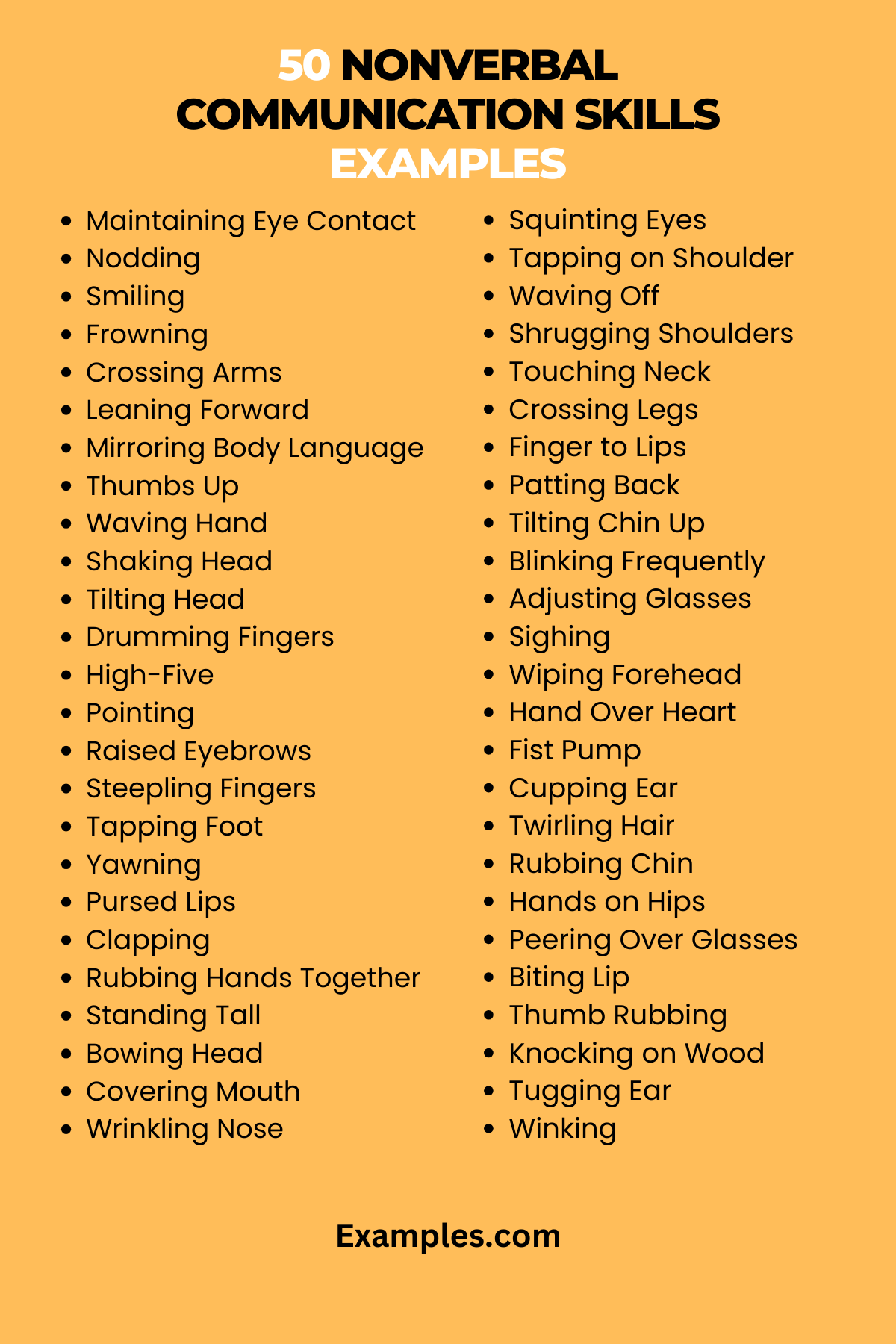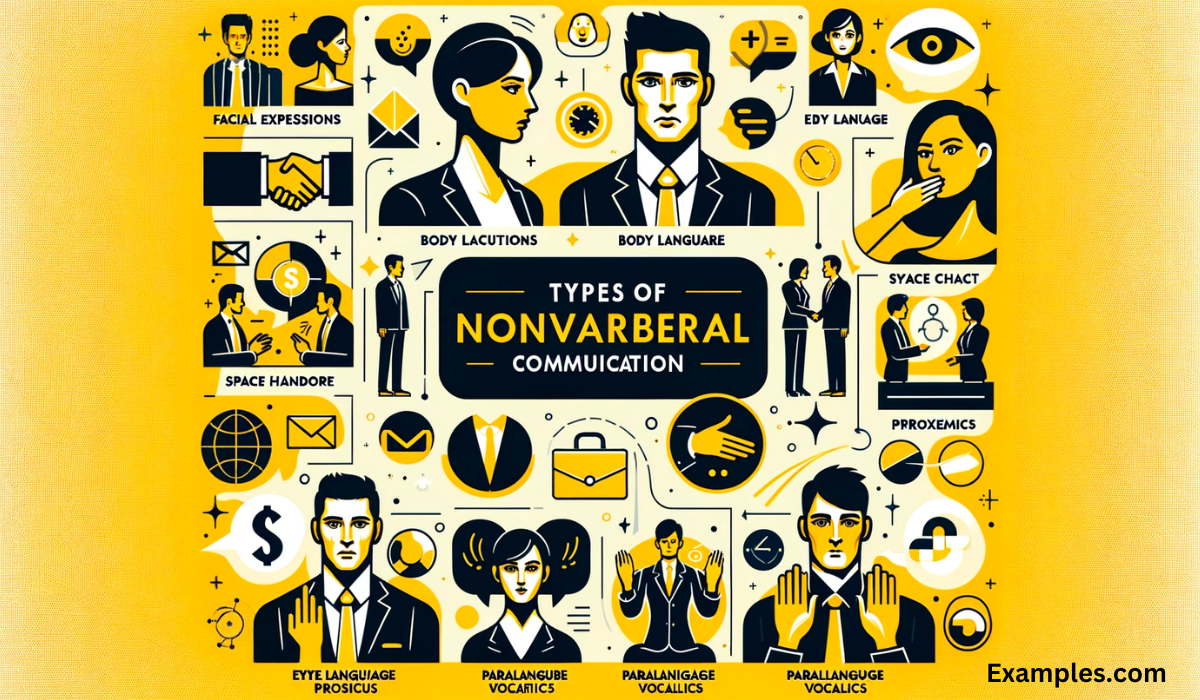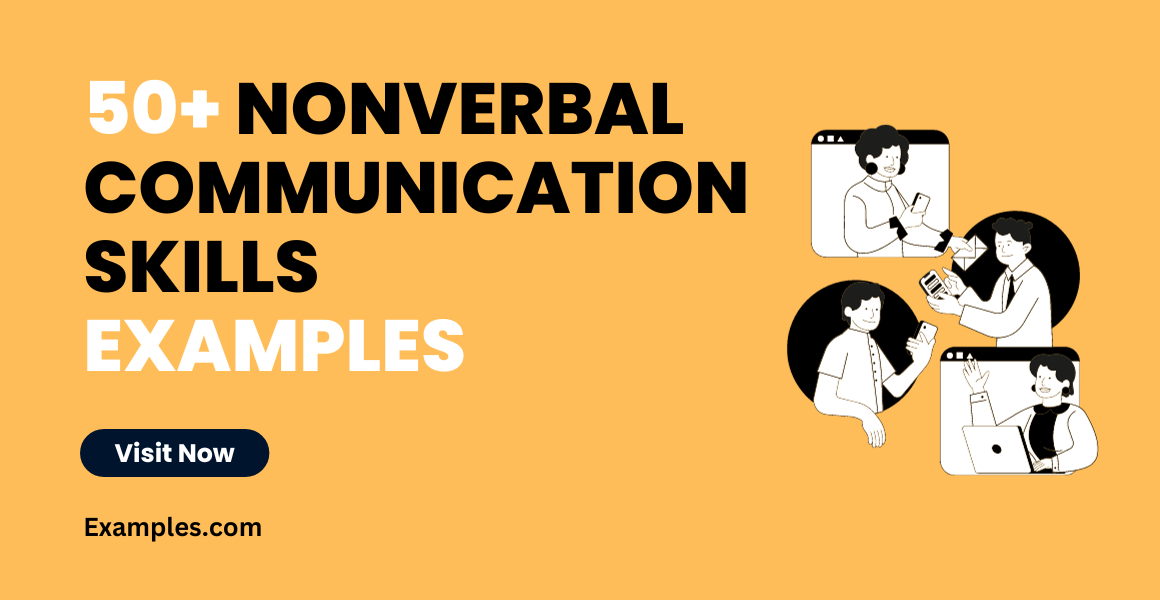49+ Nonverbal Communication Skills Examples
Understanding the nuances of nonverbal communication is vital in today’s interconnected world. Our comprehensive guide delves into the realm of Nonverbal Communication Skills, showcasing a variety of nonverbal communication examples that are crucial in both personal and professional settings. From subtle gestures to powerful body language cues, this guide offers an in-depth look into the silent yet impactful world of nonverbal communication, providing valuable insights and practical examples to enhance your nonverbal skills.
What is Nonverbal Communication Skill? – Definition
Nonverbal communication skill refers to the ability to convey and interpret messages without using words. It involves understanding and using body language, facial expressions, gestures, eye contact, and other physical cues to express oneself and to understand others. This skill is essential for effective interpersonal interactions, as it often conveys more emotion and intention than spoken words. Mastery of nonverbal communication enhances personal and professional relationships, allowing for deeper connections and better understanding.
What are the Best Nonverbal Communication Skills Examples?
Nonverbal communication is an integral part of how we interact and is often more impactful than verbal communication. One key aspect is facial expressions, which are universal indicators of emotions like happiness or anger. Body language, including posture and movements, reveals a person’s feelings and attitudes, whether it’s confidence or nervousness. Eye contact is another critical element, signifying interest, honesty, or sometimes discomfort.
Gestures, such as hand and arm movements, are powerful tools for emphasizing points or conveying specific messages. The use of touch, like a handshake or hug, communicates emotions ranging from support to affection. The space someone maintains in interactions can signal various intentions, from intimacy to assertiveness.
Incorporating nonverbal communication in daily life and understanding its nuances, like nonverbal communication symbols, enhances our ability to connect with others. The tone of voice, often considered a bridge between verbal and nonverbal communication, adds depth to our spoken words, conveying sincerity or sarcasm. These skills are essential across various contexts, from nonverbal communication at the workplace to personal relationships, making them invaluable for effective and empathetic communication.
50 Nonverbal Communication Skills Examples
Nonverbal communication skills are essential in conveying emotions, intentions, and messages without words. Mastering these skills enhances personal and professional interactions, making them more effective and empathetic. This guide offers 50 unique and distinct examples of nonverbal communication, each explained with practical usage and Example, sentences, providing a comprehensive understanding of this silent yet powerful form of communication. These skills are pivotal in nonverbal communication in daily life and nonverbal communication at the workplace, where subtle gestures and expressions can significantly impact interactions

- Maintaining Eye Contact: Demonstrates attention and interest.
Example: When listening to someone, maintain steady eye contact to show you are engaged and understanding their point. - Nodding: Signals agreement or understanding.
Example: Nod in response to a colleague’s suggestion to indicate your agreement or comprehension. - Smiling: Conveys happiness or approval.
Example: Smile when greeting someone to create a welcoming and friendly atmosphere. - Frowning: Shows disapproval or confusion.
Example: Frown slightly during a misunderstanding to signal that clarification is needed. - Crossing Arms: Can indicate defensiveness or discomfort.
Example: Avoid crossing your arms during a negotiation to prevent appearing closed off. - Leaning Forward: Implies interest and engagement.
Example: Lean in slightly during a conversation to show you are actively participating. - Mirroring Body Language: Creates rapport and empathy.
Example: Mirror the body language of a friend in a relaxed setting to build a deeper connection. - Thumbs Up: Signifies approval or agreement.
Example: Give a thumbs up after a successful team presentation to express your satisfaction. - Waving Hand: Indicates greeting or farewell.
Example: Wave when you see someone across the room to acknowledge their presence warmly. - Shaking Head: Expresses disagreement or denial.
Example: Gently shake your head when declining an offer to communicate your decision clearly. - Tilting Head: Shows curiosity or contemplation.
Example: Tilt your head when asking a thoughtful question to indicate genuine interest. - Drumming Fingers: Suggests impatience or anxiety.
Example: Avoid drumming your fingers during a meeting to prevent showing restlessness. - High-Five: Represents celebration or agreement.
Example: Offer a high-five to celebrate a team achievement, boosting morale. - Pointing: Directs attention or specifies.
Example: Point to a specific item when explaining its importance in a presentation. - Raised Eyebrows: Displays surprise or skepticism.
Example: Raise your eyebrows to express your surprise at unexpected news. - Steepling Fingers: Indicates confidence or authority.
Example: Steeple your fingers during a discussion to project confidence in your stance. - Tapping Foot: Shows impatience or nervousness.
Example: Control foot tapping during an interview to maintain a composed appearance. - Yawning: Implies tiredness or boredom.
Example: Suppress yawns during a lecture to show respect and interest. - Pursed Lips: Suggests disapproval or skepticism.
Example: Avoid pursing your lips in disagreement to maintain a neutral demeanor in discussions. - Clapping: Expresses appreciation or agreement.
Example: Clap at the end of a performance to show your enjoyment and approval. - Rubbing Hands Together: Indicates anticipation or excitement.
Example: Rub your hands together before starting a new project to show eagerness. - Standing Tall: Reflects confidence and self-assurance.
Example: Stand up straight when presenting to convey confidence in your ideas. - Bowing Head: Signifies respect or acknowledgement.
Example: Bow your head slightly in a cultural setting where this gesture is a sign of respect. - Covering Mouth: Indicates shock or hesitation.
Example: Cover your mouth briefly in surprise during an unexpected announcement. - Wrinkling Nose: Shows disgust or disapproval.
Example: Avoid wrinkling your nose in distaste to maintain politeness in social interactions. - Squinting Eyes: Indicates suspicion or scrutiny.
Example: Squint slightly when examining something closely, indicating your focus and attention to detail. - Tapping on Shoulder: Signals a request for attention.
Example: Tap someone on the shoulder gently to get their attention in a crowded room. - Waving Off: Suggests dismissal or refusal.
Example: Wave off a suggestion gently to indicate that it’s not needed at the moment. - Shrugging Shoulders: Implies uncertainty or indifference.
Example: Shrug your shoulders when you don’t have an answer to a question, signaling your uncertainty. - Touching Neck: Shows nervousness or insecurity.
Example: Avoid touching your neck during a speech to prevent appearing nervous. - Crossing Legs: Can reflect relaxation or defensiveness.
Example: Cross your legs while sitting in a casual conversation to appear relaxed and comfortable. - Finger to Lips: Indicates the need for silence.
Example: Place your finger to your lips to signal the need for quiet in a library. - Patting Back: Offers reassurance or comfort.
Example: Pat someone on the back to comfort them in a moment of distress. - Tilting Chin Up: Portrays pride or defiance.
Example: Tilt your chin up slightly to express confidence in your abilities. - Blinking Frequently: Signifies stress or disbelief.
Example: Try to control blinking rapidly in tense situations to appear calm. - Adjusting Glasses: Can indicate thoughtfulness or hesitation.
Example: Adjust your glasses while pondering a question to show you are considering it seriously. - Sighing: Expresses relief or frustration.
Example: Sigh softly after completing a difficult task to convey a sense of accomplishment. - Wiping Forehead: Shows relief or stress.
Example: Wipe your forehead after a challenging activity to express a sense of relief. - Hand Over Heart: Signals sincerity or gratitude.
Example: Place your hand over your heart to show deep appreciation or sincerity. - Fist Pump: Demonstrates victory or excitement.
Example: Do a fist pump after achieving a personal goal to express your excitement. - Cupping Ear: Indicates listening carefully or difficulty hearing.
Example: Cup your ear to signal that you’re trying to hear better in a noisy environment. - Twirling Hair: Suggests contemplation or nervousness.
Example: Avoid twirling your hair during serious conversations to maintain a professional demeanor. - Rubbing Chin: Implies deep thinking or decision-making.
Example: Rub your chin thoughtfully when considering different options. - Hands on Hips: Displays readiness or assertiveness.
Example: Place your hands on your hips when preparing to undertake a task, showing your readiness. - Peering Over Glasses: Conveys scrutiny or disbelief.
Example: Peer over your glasses to scrutinize a document closely. - Biting Lip: Indicates worry or uncertainty.
Example: Try not to bite your lip in anxiety, as it can show nervousness. - Thumb Rubbing: Suggests contemplation or apprehension.
Example: Avoid rubbing your thumb when making decisions, as it can signal hesitation. - Knocking on Wood: Represents a superstition for good luck.
Example: Knock on wood after making a hopeful statement to convey a wish for good luck. - Tugging Ear: Shows indecision or seeking attention.
Example: Tug at your ear when pondering a difficult question to indicate you are deep in thought. - Winking: Implies playfulness or inside knowledge.
Example: Wink playfully to share a light-hearted moment or a mutual understanding.
What are Nonverbal Communication Skills in Business?
In the realm of business, nonverbal communication skills play a pivotal role in shaping interactions and outcomes. These skills encompass a variety of cues and behaviors that go beyond spoken language, offering a deeper layer of understanding and interaction in the professional setting. In business, nonverbal cues include professional posture, appropriate eye contact, controlled facial expressions, and effective use of gestures during presentations. They also involve understanding the nonverbal signals of others, which can provide critical insights in negotiations, meetings, and networking.
Effective nonverbal communication in the workplace can lead to improved collaboration, stronger relationships with clients, and more effective leadership. For instance, a manager who uses open body language and maintains eye contact during team meetings conveys approachability and attentiveness. Similarly, a salesperson who is adept at reading a client’s nonverbal cues, such as interest or skepticism, can tailor their approach accordingly, increasing the likelihood of a successful interaction.
Incorporating nonverbal communication skills in business also means being mindful of cultural differences, as nonverbal cues can vary significantly across cultures. This sensitivity is crucial in today’s global business environment, where misunderstandings can have significant implications. Understanding and effectively utilizing nonverbal communication in business is not just a skill but a necessary component of professional success and intercultural competence.
The Importance of Nonverbal Communication Skills
The importance of nonverbal communication skills cannot be overstated. These skills are fundamental in conveying and interpreting emotions, intentions, and information without the use of words. In personal interactions, they enhance the depth and clarity of communication, allowing individuals to connect on a more profound level. In professional contexts, nonverbal skills are essential for effective leadership, teamwork, and client relations.
Nonverbal cues often speak louder than words. For example, a person’s posture or facial expression can instantly convey confidence, openness, or discomfort, impacting how their message is received. In situations where verbal communication is limited, such as in nonverbal communication for autism or across language barriers, nonverbal skills become even more critical.
Moreover, nonverbal communication skills are essential in understanding and respecting cultural differences. What is considered polite and respectful nonverbal behavior in one culture might be perceived differently in another. Being aware of and sensitive to these differences is key in our increasingly globalized world.
In essence, nonverbal communication skills bridge the gap between what is said and what is meant, ensuring clearer, more effective communication in all areas of life. Whether in personal relationships, educational settings, healthcare, or business, these skills play a vital role in enhancing interaction and understanding.
Types of Nonverbal Communication Skills
Nonverbal communication encompasses a wide range of skills, each playing a unique role in how we convey and interpret messages. Understanding these different types can greatly enhance interpersonal interactions. Here are the key types:

- Facial Expressions: One of the most direct ways to convey emotions, ranging from happiness and surprise to anger and sadness. Essential in nonverbal communication in different cultures, facial expressions can bridge language barriers.
- Body Language and Posture: The way we sit, stand, and move communicates a lot about our confidence, attentiveness, and openness. This aspect of nonverbal communication at the workplace is crucial for professional demeanor.
- Gestures: Hand and arm movements can emphasize points, express ideas, and convey various emotions. Gestures are key components in nonverbal communication for teachers and public speakers.
- Eye Contact: Maintaining, avoiding, or breaking eye contact sends strong signals about interest, honesty, and confidence, especially in nonverbal communication for nurses and healthcare professionals.
- Touch: A handshake, pat, or hug can communicate support, affection, or dominance. Touch is a sensitive aspect of nonverbal communication with pictures in media.
- Space (Proxemics): How we use physical space tells about intimacy, aggression, or formality in our relationships. Understanding space is vital in nonverbal communication in movies and theatrical performances.
- Paralanguage (Vocalics): Variations in tone, pitch, and speed of our voice add meaning to our verbal communication. This aspect is crucial in nonverbal communication for autism, where vocal tone can be more expressive than words.
- Physiological Changes: Blushing, sweating, or paleness can reveal our emotional state. Observing these changes is important in nonverbal communication for pain assessment in healthcare.
Verbal and Nonverbal Communication Skills
Creating a comparative table to understand the differences and interplay between verbal and nonverbal communication skills:

| Aspect | Verbal Communication | Nonverbal Communication |
|---|---|---|
| Definition | Involves the use of words in conveying messages, either spoken or written. | Involves conveying messages without words, using body language, facial expressions, gestures, etc. |
| Clarity | Can be more explicit and direct. | Often more subtle and open to interpretation. |
| Emotional Impact | Usually less effective in conveying emotions compared to nonverbal cues. | Highly effective in conveying emotions and attitudes. |
| Cultural Influence | More likely to vary significantly across different languages and cultures. | Some aspects like basic facial expressions are universal, but others can vary culturally. |
| Usage | Predominant in formal communication, education, and written correspondence. | Predominant in personal interactions, expressing feelings, and non-verbal learning environments. |
| Feedback | Feedback can be immediate in conversations but delayed in written form. | Feedback is often immediate and intuitive. |
| Misinterpretation | Can be misinterpreted due to language barriers or lack of clarity in expression. | Can be misinterpreted due to cultural differences or personal biases in interpreting cues. |
How to Improve your Nonverbal Communication Skills
Improving nonverbal communication skills can significantly enhance your ability to interact and connect with others. Here are some tips:
- Observe Others: Pay attention to how others use nonverbal communication. Notice how their gestures, facial expressions, and posture affect your perception of their messages.
- Practice Self-Awareness: Reflect on your nonverbal cues. Are you maintaining eye contact? Is your body language open or closed? Adjust accordingly.
- Seek Feedback: Ask for honest feedback from friends, family, or colleagues about your nonverbal communication.
- Mirror Successful Examples: Try to emulate the nonverbal behavior of effective communicators around you.
- Learn About Cultural Differences: Understanding cultural nuances in nonverbal communication can prevent misunderstandings in diverse settings.
- Watch Your Facial Expressions: Ensure your facial expressions match your words and emotions.
- Improve Your Listening Skills: Active listening involves more than just hearing words; it’s also about paying attention to nonverbal signals sent by the speaker.
- Attend Workshops or Training Sessions: Consider professional training to enhance your nonverbal communication skills.
- Practice in Real-Life Situations: Apply what you learn in your daily interactions and observe the outcomes.
- Stay Open to Learning: Nonverbal communication is complex, and there is always more to learn and understand about how we convey and interpret unspoken messages.
These strategies are particularly effective in enhancing nonverbal communication in daily life and nonverbal communication at the workplace, helping to build stronger, more effective interpersonal relationships.
In conclusion, mastering nonverbal communication skills is essential for effective interpersonal interactions. This guide has provided a comprehensive understanding of nonverbal cues, from facial expressions to body language, and offered practical tips for improvement. Embracing these skills enhances clarity and emotional depth in communication, ensuring more meaningful and successful connections in both personal and professional realms.



